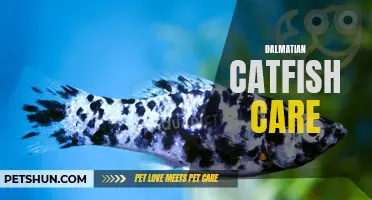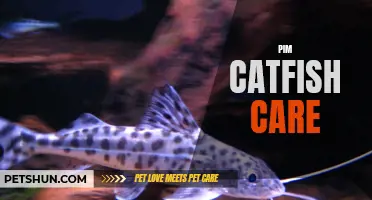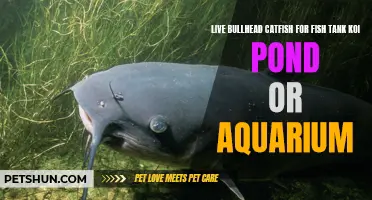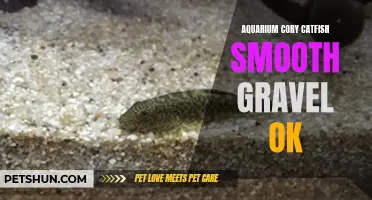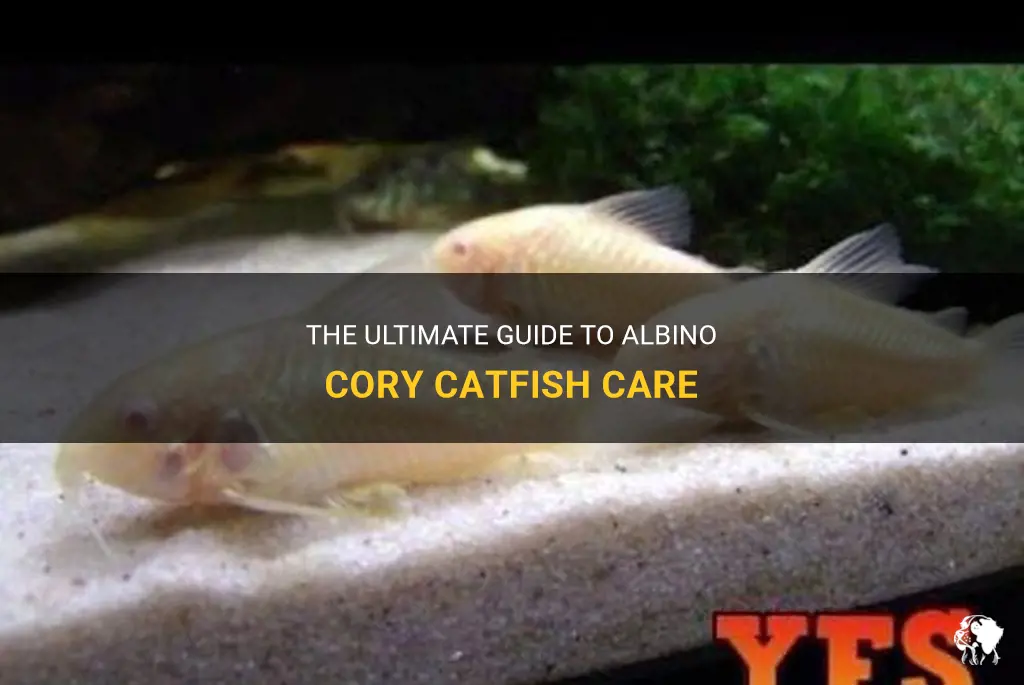
Albino cory catfish, known for their strikingly white appearance and playful nature, are a popular choice among fish enthusiasts. Their unique coloration and sociable behavior make them an attractive addition to any aquarium. However, like any fish, they require proper care and attention to ensure their health and well-being. In this article, we will delve into the world of albino cory catfish care, exploring their habitat, feeding habits, and overall maintenance, providing you with the knowledge and guidelines necessary to create a thriving environment for these captivating fish.
| Characteristics | Values |
|---|---|
| Scientific Name | Corydoras aeneus |
| Common Name | Albino Cory Catfish |
| Family | Callichthyidae |
| Origin | South America |
| Size | Up to 2.5 inches |
| Lifespan | 5-7 years |
| Aquarium Size | 10 gallons or larger |
| Water Parameters | pH 6.0-8.0, temperature 72-78°F, soft to moderately hard water |
| Tank Decorations | Plants, hiding spots, smooth substrate |
| Diet | Omnivorous, prefers sinking pellets, frozen or live food |
| Behavior | Peaceful, shoaling fish |
| Compatibility | Peaceful community fish |
| Tank Mates | Other small, peaceful fish |
| Breeding | Egg layers, need separate breeding tank |
| Special Considerations | Albino fish are more sensitive to lighting and prone to sunburn |
What You'll Learn
- What are the specific dietary requirements for albino cory catfish?
- What are the ideal water parameters for maintaining albino cory catfish in a home aquarium?
- How often should albino cory catfish be fed, and what is the recommended portion size?
- Are there any special considerations for tank mates when keeping albino cory catfish?
- What are common health issues that albino cory catfish may experience, and how can they be prevented or treated?

What are the specific dietary requirements for albino cory catfish?
Albino cory catfish are a popular choice for aquarium enthusiasts due to their unique appearance and peaceful nature. Like all fish, they have specific dietary requirements to ensure their health and vitality. In this article, we will explore the specific dietary needs of albino cory catfish and provide guidance on how to meet those requirements.
Albino cory catfish, also known as Corydoras aeneus, are omnivorous creatures, meaning they will eat both plant matter and animal protein. A balanced diet is essential to their overall well-being. In their natural habitat, these catfish feed on various food sources, including insects, worms, crustaceans, and plant matter.
To replicate their natural diet in captivity, it is important to provide a mix of high-quality fish pellets, live or frozen foods, and vegetables. A good quality pellet formulated specifically for bottom-dwelling catfish should be the main staple in their diet. These pellets should be sinking pellets, as albino cory catfish are bottom-dwelling creatures and prefer to feed on the substrate.
In addition to pellets, live or frozen foods should be incorporated into their diet to provide them with necessary animal protein. Some good choices include bloodworms, brine shrimp, daphnia, and blackworms. These foods can be purchased at most pet stores or online and should be thawed or rinsed before feeding.
Vegetables should also be included in their diet to provide essential vitamins and nutrients. Some suitable options include blanched zucchini, spinach, peas, and cucumber. These vegetables should be cut into small pieces and blanched briefly in boiling water before being offered to the catfish. It is important to remove any uneaten vegetables after a couple of hours to prevent water pollution.
Feeding frequency is another important consideration when it comes to the dietary requirements of albino cory catfish. Ideally, they should be fed small amounts several times a day to mimic their natural feeding habits. Overfeeding can lead to health problems, such as obesity or poor water quality, so it is important to provide only the amount of food that they can consume within a few minutes.
One method to ensure that they receive a balanced diet is to incorporate a feeding schedule. For example, feeding them pellets in the morning, live or frozen foods in the afternoon, and vegetables in the evening can provide a balanced and varied diet. By following this schedule, you can be confident that your albino cory catfish are receiving all the necessary nutrients for optimal health.
It is worth mentioning that the dietary requirements may vary slightly depending on the age and size of the catfish. Younger catfish may require more protein-rich foods to support their growth, while adult catfish can be provided with a greater amount of vegetables. Regular monitoring of their behavior and body condition can help determine if any adjustments need to be made to their diet.
In conclusion, albino cory catfish have specific dietary requirements that need to be met for their overall health and well-being. A balanced diet consisting of high-quality pellets, live or frozen foods, and vegetables is essential. Feeding small amounts several times a day and incorporating a feeding schedule can ensure that they receive all the necessary nutrients. Remember to monitor their behavior and body condition and make adjustments to their diet as needed. By meeting their dietary needs, you can enjoy the beauty and companionship of these unique fish for years to come.
The Ultimate Guide to Red Tailed Catfish Care
You may want to see also

What are the ideal water parameters for maintaining albino cory catfish in a home aquarium?
Maintaining albino cory catfish in a home aquarium requires careful attention to water parameters. These small, peaceful catfish make excellent additions to community tanks, but they do have specific needs for water quality. By ensuring that their environment is properly maintained, you can help your albino cory catfish thrive and live a long, healthy life.
Water Temperature:
Albino cory catfish are tropical fish and require a consistent water temperature between 72°F and 78°F (22°C-26°C). It is essential to use a reliable aquarium heater to maintain a stable temperature. Sudden temperature fluctuations can stress the fish and compromise their immune system, making them more susceptible to diseases.
PH Level:
The ideal pH range for albino cory catfish is between 6.5 and 7.5. These catfish can tolerate slight variations outside this range but maintaining stability is crucial. A sudden shift in pH can cause stress and negatively impact their overall health. Regularly monitor the pH levels using a high-quality aquarium test kit and make adjustments if necessary.
Ammonia and Nitrite Levels:
Albino cory catfish are sensitive to ammonia and nitrite, which are toxic substances produced by decaying food and fish waste. It is crucial to establish and maintain a biological filtration system that can effectively convert ammonia into less harmful compounds. Regular water changes, along with the use of a quality filter and conditioner, will help keep ammonia and nitrite levels at bay.
Nitrate Levels:
Nitrate, the end product of the nitrogen cycle, can accumulate in the tank if not properly managed. High nitrate levels can cause stress, poor growth and can lead to health issues in albino cory catfish. It is recommended to keep nitrate levels below 40 ppm by performing regular water changes and ensuring efficient biological filtration.
Water Hardness:
Albino cory catfish prefer soft to slightly hard water, with a general range of 2-15 dGH (German degrees of hardness). To maintain the desired water hardness, you may need to use a water conditioner or specific additives to adjust the parameters to suit the needs of the catfish.
Oxygen Levels:
Adequate oxygen levels in the aquarium are vital for the health of all fish, including albino cory catfish. Make sure your tank has proper aeration and surface agitation to facilitate gas exchange. This can be achieved using air stones, bubble wands, or an efficient filter.
In addition to maintaining proper water parameters, it is essential to provide a suitable environment for albino cory catfish. They are social creatures and should be kept in groups of six or more to minimize stress. Decorate the tank with plants, rocks, and hiding spots to create a natural habitat. Avoid sharp edges or rough substrates that can injure their delicate barbels.
Regularly monitor the water parameters and perform routine maintenance to ensure a healthy environment for your albino cory catfish. By providing them with ideal water conditions, you can enjoy the beauty and charm of these unique catfish for many years to come.
The Complete Guide to Caring for Upside Down Catfish: Tips and Advice
You may want to see also

How often should albino cory catfish be fed, and what is the recommended portion size?
Albino cory catfish, also known as albino Corydoras or Corydoras paleatus, are popular aquarium fish known for their peaceful nature and unique appearance. They have a white or pale pink coloration due to a lack of pigmentation. If you are lucky enough to have these fascinating fish in your aquarium, it is essential to provide them with a proper diet to ensure their health and well-being.
Feeding Frequency:
Albino cory catfish are bottom-dwelling scavengers, and they have evolved to eat small insects, crustaceans, and plant matter in their natural habitat. In an aquarium setting, it is recommended to feed them once or twice a day. Overfeeding can lead to water quality issues and obesity, so it's important to strike a balance. By feeding them once or twice a day, you ensure they receive enough nutrition without excess.
Portion Size:
Determining the appropriate portion size for your albino cory catfish can be a bit tricky as it depends on several factors such as the size of the fish, the type of food, and the overall population of the aquarium. A good rule of thumb is to feed them an amount that they can consume within a few minutes.
One common mistake many aquarists make is putting too much food in the tank. Uneaten food can quickly decompose, leading to poor water quality. It's better to slightly underfeed your catfish than to overfeed them. Keep in mind that their stomachs are relatively small, so a little goes a long way.
Types of Food:
Albino cory catfish are omnivores, meaning they eat both animal and plant matter. Commercially available foods specifically formulated for bottom-dwelling fish, such as sinking pellets or wafers, are a good option. These foods sink to the bottom of the tank, allowing the catfish to feed comfortably.
In addition to commercial foods, it is also beneficial to supplement their diet with small live or frozen foods like brine shrimp, bloodworms, and daphnia. These foods provide essential nutrients and mimic their natural diet. You can offer these treats once or twice a week to add variety to their diet and satisfy their natural foraging instincts.
Tips for Feeding Albino Cory Catfish:
- Observe their feeding behavior: Cory catfish have a unique way of feeding. They use their tapered mouths to sift through the substrate, searching for food particles. Take the time to watch and learn their habits to ensure they are getting enough to eat.
- Clean up excess food: If you notice any uneaten food after feeding, use a siphon or net to remove it from the tank. This will prevent it from decomposing and affecting water quality.
- Provide hiding places: Albino cory catfish appreciate hiding places in the form of caves, driftwood, or plants. These hiding spots simulate their natural habitat and help them feel secure. Providing a comfortable environment will encourage them to come out and feed.
In conclusion, albino cory catfish should be fed once or twice a day with a portion size they can consume within a few minutes. A balanced diet of sinking pellets or wafers supplemented with small live or frozen foods is ideal. Observing their feeding behavior, cleaning up excess food, and providing hiding places will ensure their overall health and happiness in your aquarium. With proper care and nutrition, your albino cory catfish will live a long and healthy life.
The Essential Guide to Glass Catfish Care: Tips and Advice for Keeping these Transparent Beauties
You may want to see also

Are there any special considerations for tank mates when keeping albino cory catfish?
Albino cory catfish, also known as albino Corydoras, are a popular choice for aquarium enthusiasts due to their striking appearance and peaceful nature. These small catfish are typically white or pale in color, with red or pink eyes. Keeping albino cory catfish in a community tank can be a delightful experience, but there are a few special considerations to keep in mind when choosing tank mates.
- Compatibility: Albino cory catfish are very social fish and thrive in groups of at least six individuals. When selecting tank mates, it is important to choose fish that are peaceful and compatible with their peaceful nature. Avoid aggressive or territorial fish species, as they can stress out the cory catfish and even cause physical harm.
- Size: Albino cory catfish are relatively small, reaching an average size of around 2-3 inches. Therefore, it is crucial to choose tank mates that are similar in size or smaller to prevent any accidental injuries. Larger fish may view the cory catfish as potential prey and may attempt to swallow them whole.
- Water Parameters: Albino cory catfish prefer water conditions that are similar to their natural habitat. They thrive in soft, slightly acidic water with a pH between 6.0 and 7.5. It is important to select tank mates that have similar water parameter requirements to ensure the health and well-being of all the fish in the aquarium.
- Bottom Dwellers: Albino cory catfish are primarily bottom-dwellers, searching for food and hiding among the substrate. When choosing tank mates, it is essential to consider fish that inhabit different levels of the tank to minimize competition for space and resources. Look for mid-level or top-dwelling fish species that will complement the cory catfish's bottom-dwelling behavior.
Examples of suitable tank mates for albino cory catfish include:
- Tetras: Small tetra species such as neon tetras or ember tetras are peaceful and make excellent tank mates for albino cory catfish. These fish prefer similar water conditions and occupy different areas of the tank, creating a visually appealing and harmonious community.
- Dwarf Gouramis: Dwarf gouramis are colorful and peaceful fish that can coexist with albino cory catfish. They occupy the mid to top levels of the tank, complementing the cory catfish's bottom-dwelling behavior.
- Rasboras: Rasboras, like harlequin rasboras or chili rasboras, are peaceful schooling fish that can be excellent companions for albino cory catfish. They are typically small in size and occupy different levels of the tank, promoting a diverse and balanced community.
Overall, when selecting tank mates for albino cory catfish, it is essential to consider their social nature, size compatibility, water parameter requirements, and habitat preferences. By choosing peaceful, similarly sized fish species that inhabit different levels of the tank, you can create a vibrant and harmonious community aquarium.
Mastering the Art of Raphael Catfish Care: A Comprehensive Guide
You may want to see also

What are common health issues that albino cory catfish may experience, and how can they be prevented or treated?
Albino cory catfish, also known as albino corydoras, are a popular addition to many freshwater aquariums. These unique fish are prized for their vibrant white coloration, which is a result of a genetic mutation that causes a lack of pigmentation. While albino cory catfish are generally hardy and easy to care for, they can still be prone to certain health issues. In this article, we will explore some common health issues that albino cory catfish may experience and discuss how they can be prevented or treated.
One common health issue that albino cory catfish may experience is swim bladder disease. The swim bladder is an organ that helps fish maintain buoyancy in the water. When the swim bladder becomes infected or inflamed, it can cause the fish to have difficulty swimming or even float upside down. Swim bladder disease can be caused by a variety of factors, including poor water quality, overfeeding, or a bacterial or parasitic infection.
To prevent swim bladder disease, it is important to maintain clean and healthy water conditions in the aquarium. Regular water changes and proper filtration are essential for keeping the water quality high. Overfeeding should also be avoided, as excess food can lead to digestive issues and swim bladder problems. If a fish does develop swim bladder disease, treatment may involve adjusting the fish's diet and feeding schedule, as well as providing a stress-free environment with plenty of hiding places.
Another common health issue that can affect albino cory catfish is fin rot. Fin rot is a bacterial infection that can cause the fish's fins to become frayed, ragged, or discolored. It is typically caused by poor water quality, stress, or injuries. Preventing fin rot involves maintaining a clean and well-maintained aquarium, with regular water testing and appropriate filtration. Adding aquarium salt to the water can also help prevent bacterial infections. If a fish does develop fin rot, treatment may involve using a suitable antibiotic medication and ensuring the fish has a healthy and balanced diet.
Albino cory catfish can also be susceptible to external parasites, such as ich (white spot disease) or velvet. These parasites are often introduced to the aquarium through new fish or plants, and can quickly spread to other tank inhabitants. To prevent the spread of parasites, it is important to quarantine new fish and plants before introducing them to the main aquarium. Maintaining optimal water conditions and a stress-free environment can also help prevent infestations. If a fish does become infested with parasites, treatment may involve using a suitable medication, adjusting water temperature, and ensuring the infected fish has access to proper nutrition.
In conclusion, albino cory catfish are generally hardy fish, but they can still be prone to certain health issues. It is important to maintain clean and healthy water conditions, feed a balanced diet, and provide a stress-free environment to help prevent these health issues. If a fish does develop a problem, prompt treatment and proper care can often lead to a full recovery. By being proactive and attentive to their needs, albino cory catfish can thrive and bring joy to aquarium enthusiasts for years to come.
The Ultimate Guide to Featherfin Catfish Care: Tips and Tricks for a Healthy and Happy Fish
You may want to see also
Frequently asked questions
Albino cory catfish are omnivorous and will eat a variety of foods. They should be fed a balanced diet that includes sinking pellets or flakes specifically formulated for bottom feeders, frozen or live foods such as bloodworms or brine shrimp, and occasional vegetable matter such as blanched spinach or peas. It is important to ensure that they have a well-rounded diet to meet their nutritional needs.
Albino cory catfish are small and peaceful fish that can be kept in a variety of tank setups. They prefer a tank that mimics their natural environment, which includes sandy or fine-gravel substrate, driftwood or rocks for hiding places, and plenty of plants to provide cover. It is important to provide them with a well-maintained tank with good water quality and a temperature range of 72-78 degrees Fahrenheit.
Albino cory catfish are generally peaceful and can be kept with other small, non-aggressive fish. They are social in nature and should be kept in groups of at least 6 individuals. They may become stressed or aggressive if kept alone or in small numbers. It is important to choose tankmates that are not overly aggressive or fin-nipping, as this can cause stress and injury to the catfish.
Albino cory catfish should be fed small amounts of food multiple times a day. They have a high metabolism and require frequent feeding to ensure they receive enough nutrients. It is recommended to feed them 2-3 times a day, offering only as much food as they can consume within a few minutes. Overfeeding can lead to water quality issues and obesity, so it is important to monitor their feeding habits and adjust accordingly.
While albino cory catfish are generally hardy and resistant to diseases, they are still susceptible to common fish ailments such as fin rot, bacterial infections, and parasites. It is important to maintain good water quality, provide a varied diet, and monitor their behavior and appearance for any signs of illness. If any issues arise, it is recommended to consult with a knowledgeable aquarium professional or veterinarian who specializes in fish health to ensure proper diagnosis and treatment.


